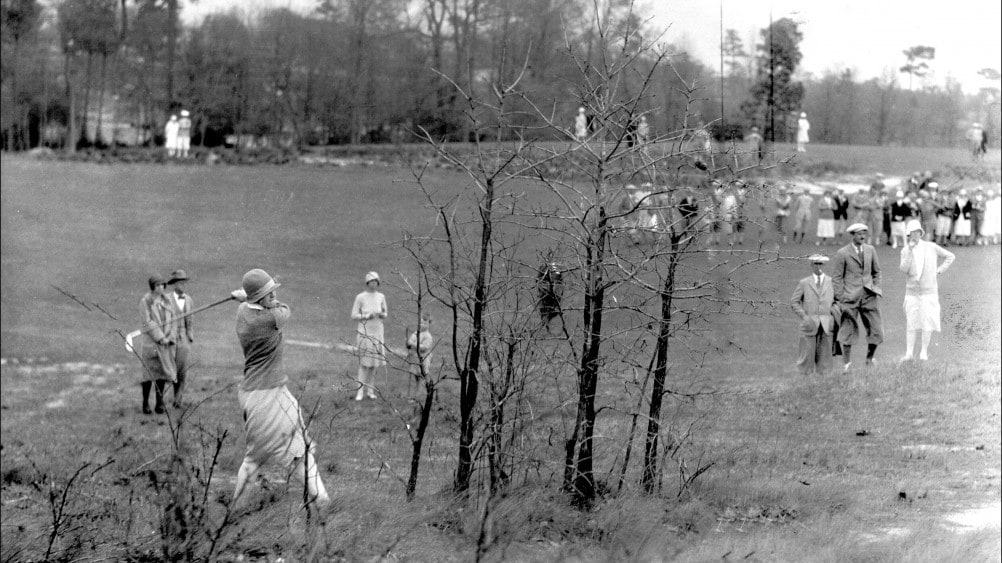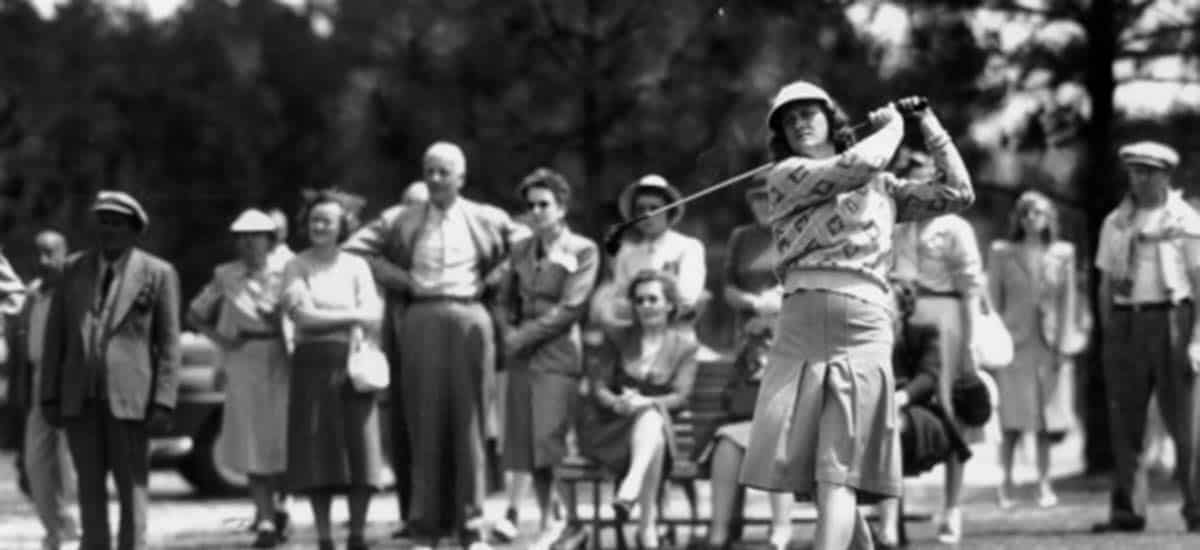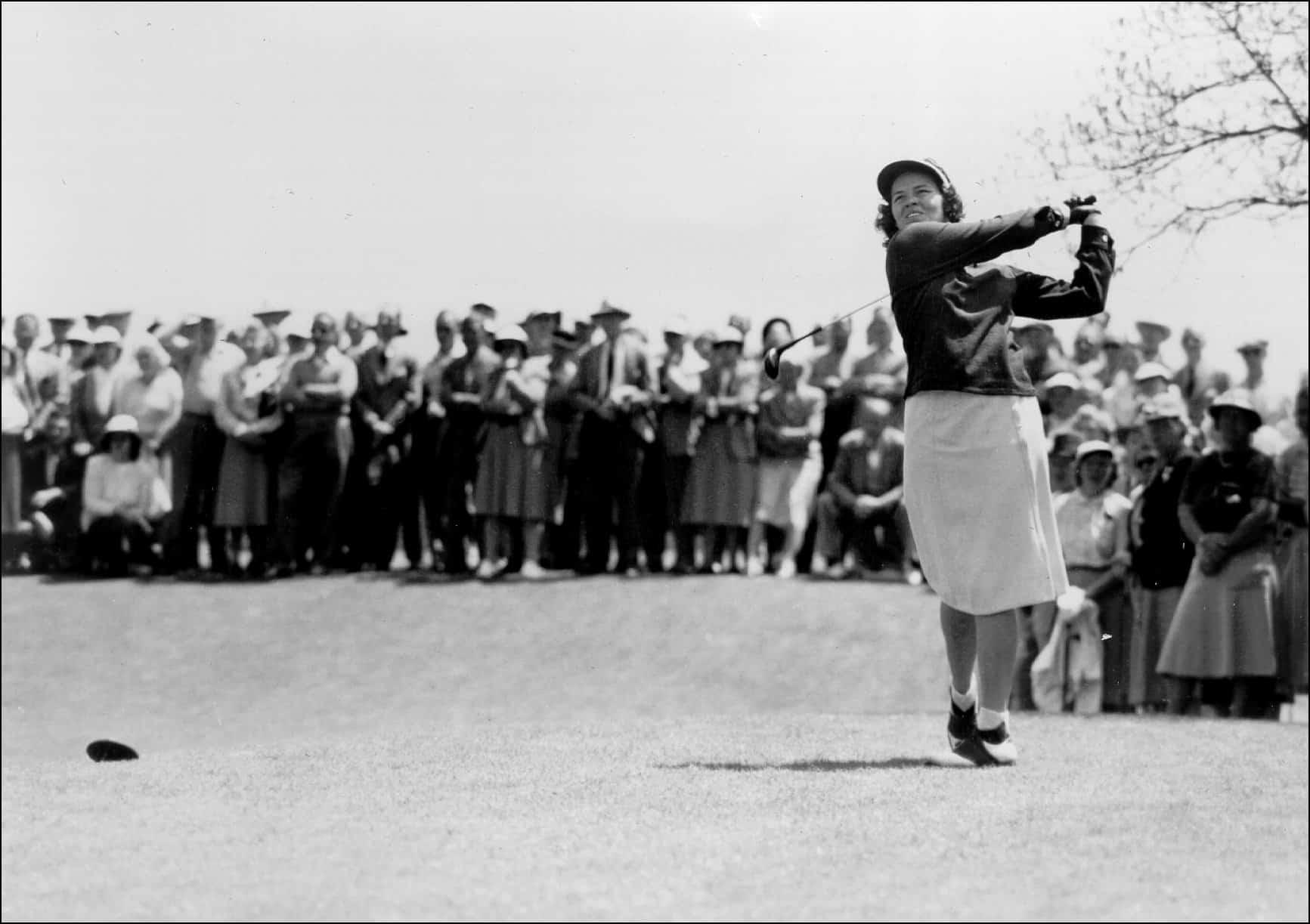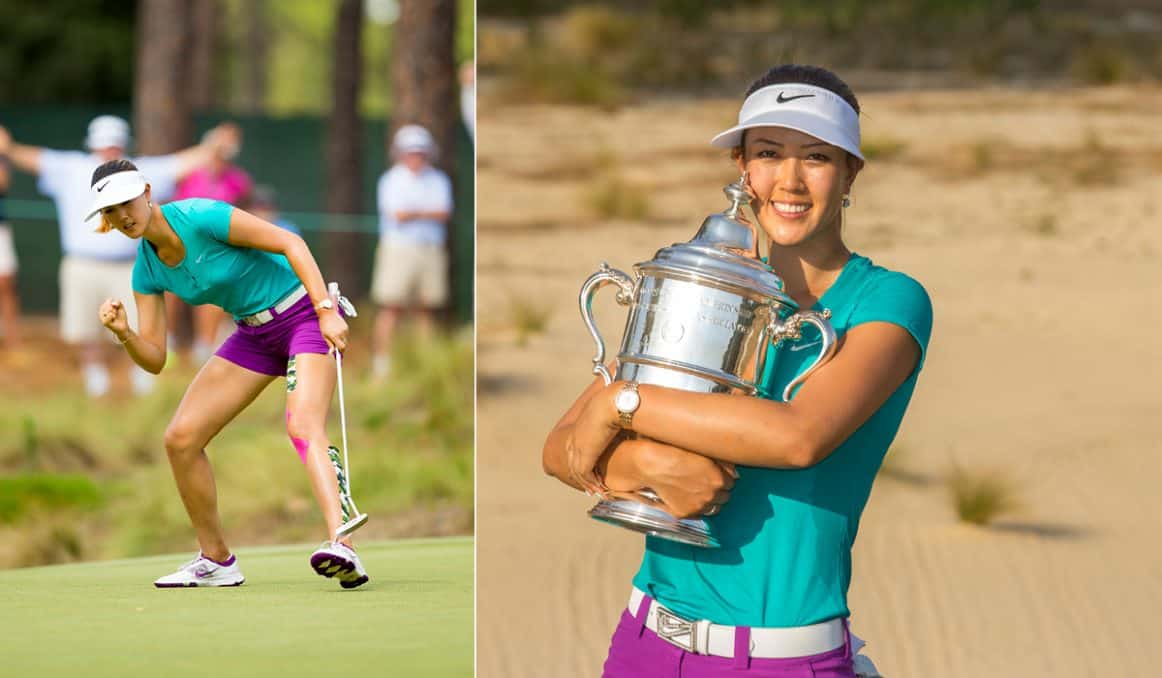All Photos Courtesy of the Tufts Archives
Maureen Orcutt, Estelle Lawson Page, Louise Suggs, Babe Zaharias and Peggy Kirk Bell excelled early in the male-dominated sport, laying the groundwork for future stars like Danielle Kang and Michelle Wie, who also prevailed at Pinehurst.
Annie Oakley was an interloper in the world of sharpshooting, and worked and lived at Pinehurst. Aviation pioneer Amelia Earhart, the first female to fly solo across the Atlantic Ocean, was a frequent guest at the Carolina Hotel. She flew her Beech-Nut Autogyro in and out of Pinehurst Flying Field in the early 1930s.
Here we’ll take a look back at some of the legendary women who have left their mark at Pinehurst.

Maureen Orcutt hits out of trouble during the Women’s North & South Amateur.
Three wins at Pinehurst weren’t enough for Maureen Orcutt. She claimed victories during the 1931, ’32 and ’33 North and South Amateurs and came back to win the North and South Senior three more times during the early 1960s. “I loved to play Pinehurst No. 2,” she told Lee Pace for his book “Pinehurst Stories,” A Celebration of Great Golf and Good Times.” “I could hit the ball. I used to be a hitter, they’d say, and I loved to let out, and you could let out on No. 2.”
But it was also Orcutt’s mastery of Pinehurst’s greens that led to her triumphs, foreshadowing a way generations after her would try.
During Orcutt’s first trip to Pinehurst in 1931 she was surprised to find sand greens. Her heyday in Pinehurst came at a time when technology and knowledge of growing various grasses hadn’t yet advanced to where grass greens could be planted.
“It was very strange: they had sand greens,” she said. “It was an entirely different game. We used what we called the ‘Texas wedge.’ – the putter – from 50 yards in. You couldn’t hit the ball to the greens because it would bounce over on those hard greens. If you could hit a straight putt you’d be a good place. There wasn’t any break at all to the putts.”

Annie Oakley made Pinehurst her home in 1916.
Annie Oakley had already made a name for herself as part of Buffalo Bill’s Wild West Show when she arrived in Pinehurst in 1916.
After she and husband Frank Butler joined the staff of the Carolina Hotel, she taught shooting lessons and hosted exhibitions. Butler managed the Pinehurst Gun Club.
Oakley is estimated to have helped thousands to nail the bric-a-brac pigeons flying around the gun club every winter through 1922. Her bird dog, Dave, was popular for his act of sniffing out money from exhibition spectators that would later be donated to the Red Cross.
Babe Zaharias tees off during her history win at the 1947 Women’s North & South Amateur.
Babe Zaharias had won 13 straight tournaments when the Women’s North & South Amateur kicked off on Pinehurst No. 2 during the second week of April in 1947.
After edging Louise Suggs to claim the North & South title, she went on to win three other tournaments during a streak known as the “Slam Bang.” Zaharias won 17 consecutive golf competitions from Texas to Pinehurst between 1946 and ‘47.
Suggs was a 23-year-old golfer from Atlanta who had won two North & South Amateurs in 1942 and ’46 and would later become a heated rival with Zaharias on the LPGA Tour, which was founded in 1950. The Pinehurst Outlook noted that Suggs seemed to garner the sympathy of the gallery and that it was only human nature as the fans “wanted to see the little one beat the strong one.” Suggs conceded an early putt to Zaharias and soon after Zaharias refused the same courtesy toward Suggs, who then missed the short putt.
“After this incident, the match became a real fight,” the publication noted.
Babe was 1-up going to the 18th hole, but her approach shot flew to the right and landed against a tree. She tried a bank shot against the tree that didn’t work out and she lost the hole, forcing a playoff.
“That almost killed me,” Babe said. “George was just going crazy. He later said, ‘I thought for sure you were going to lose one and break the string.’”
Suggs flew the green with her approach on the second extra hole, made bogey and Zaharias left Pinehurst with victory No. 14 secure. From there she won the women’s division of an event called the Celebrities Tournament in Washington, traveled to Scotland to win the Women’s British Amateur and returned home to win the Broadmoor Invitation again. Her streak of 17 ended when she lost in October in the Texas Women’s Open. Soon after, Babe accepted $300,000 from a Hollywood filmmaker for a series of golf instructional films and turned pro.
The name Babe Didrikson Zaharias occupies a mere one line on the champions board in the Pinehurst clubhouse.
But, as so often seems the case, it notes another moment when one of golf’s greatest legends and Pinehurst intersect.

Peggy Kirk Bell at Pinehurst.
Peggy Kirk crashed the party the first time she visited Pinehurst at 22 years old.
The Rollins College student heard about the Women’s North & South Amateur and decided she’d like to play so, naturally, she threw her clubs into her ’41 Packard convertible and headed North.
“I loved golf and I’d heard that Pinehurst was the golf capital of the world,” she said. “I said, ‘Gosh, I need to go play in that tournament.’”
But Kirk was in for a surprise.
When she walked into the clubhouse to register, she was asked for her invitation.
“Invitation?” she asked. “I’m sorry, gee, I’m just a college kid, I read about it and thought I’d like to play in it.”
The official excused himself for a moment and reappeared with a man donning wire-rimmed glasses.
“Hello,” he said. “I’m Richard Tufts, and I’d like to extend an invitation to you to play in the North & South.”
When Lee Pace interviewed Kirk, now Peggy Kirk Bell, for his book “Pinehurst Stories: A Celebration of Great Golf and Good Times,” she doubled over in laughter thinking about that day.
“My first trip to Pinehurst and I crash the party,” she said. “I was soooo green. I just thought it was a tournament that you paid your $5 and played. I was so embarrassed I could have died. There wasn’t even an entry fee!”
It wouldn’t take long for Bell to establish her credentials as one of the best players in amateur golf and later one of the pioneering members of the fledging LPGA tour. In 1949, she won the Palm Beach Championship and the Titleholders, the ladies’ version of the Masters held at Augusta Country Club. Then it was on to Pinehurst in late April for the North & South.
“The women had played on course No. 3 every year,” Peggy says. “It was a good course but it was short. We kept saying we wish they’d put us on the ‘big course’—No. 2. Finally they did in 1949. There was a lot of excitement that year playing on No. 2.”
Peggy bested a field of 64 players to win that North & South, including a 1-up semifinal win over Estelle Page, one of the top players in the game. She then defeated the reigning U.S. Amateur champion, Grace Lenczyk, in the championship match by a 5-and-4 margin.

Michelle Wie reacts after making a 25-foot birdie putt on the 17th hole during Sunday’s final round of the 2014 U.S Women’s Open. (USGA)
Fifteen years earlier, Payne Stewart settled over a crucial putt on the par-3 17th hole at Pinehurst No. 2, a U.S. Open championship in the balance. Stewart and Phil Mickelson were tied for the 1999 Open lead through 70 holes, with Mickelson striking his approach on 17 to 6 feet and Stewart nailing his to 4 feet. Mickelson’s putt slid past the hole and Stewart poured his into the heart of the cup, taking a one-shot lead that he preserved with his much-memorialized par on the final hole.
“It was a gimme,” caddie Mike Hicks said of the fateful birdie on 17. “Payne hadn’t missed inside 4 feet all week.”
Now it was Michelle Wie’s turn to make history on the 161-yard hole, her 8-iron nestling down 25 feet above and to the right of the front-left hole location. Wie had just double-bogeyed the 16th hole, letting a seemingly comfortable three-shot lead in the U.S. Women’s Open over Stacy Lewis shrink to a single shot. Lewis was now hitting balls on the practice range in the event of a playoff, and Wie settled into her unique table-top putting stance, where her upper torso is at 90 degrees to her long legs, the better to let her see the correct line from a head position nearer the ground.
If the 6 on 16 was giving her the shakes and sweats, she wasn’t letting on.
“I laughed it off,” she said. “Stuff like that does happen.”
Wie read a double-break on the putt, struck it with the perfect speed and the ball did just as she thought. It tumbled into the hole and the normally reserved and stoic 24-year-old emphatically pumped her fist twice as she marched to the hole and retrieved her ball with a flourish.
“That kind of emotion, that kind of pressure—I’ll think of that putt as one of the best putts I’ve ever hit in my entire life,” she said.
Now with a two-shot cushion, Wie made a routine on par on 18 and collected her first major championship, bringing to a close a memorable and historic fortnight in Pinehurst.

